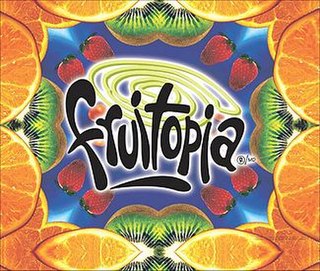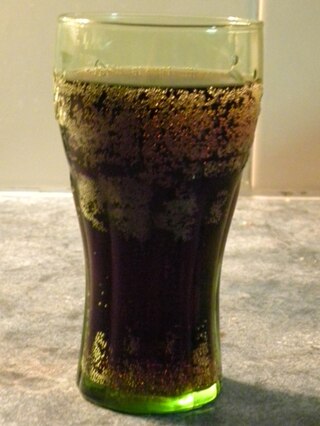
Coca-Cola, or Coke, is a carbonated soft drink with a cola flavor manufactured by the Coca-Cola Company. In 2013, Coke products were sold in over 200 countries worldwide, with consumers drinking more than 1.8 billion company beverage servings each day. Coca-Cola ranked No. 87 in the 2018 Fortune 500 list of the largest United States corporations by total revenue. Based on Interbrand's "best global brand" study of 2020, Coca-Cola was the world's sixth most valuable brand.

Pepsi is a carbonated soft drink with a cola flavor, manufactured by PepsiCo. As of 2023, Pepsi is the second most valuable soft drink brand worldwide behind Coca-Cola; the two share a long-standing rivalry in what has been called the "cola wars".

A soft drink is any water-based flavored drink, usually but not necessarily carbonated, and typically including added sweetener. Flavors used can be natural or artificial. The sweetener may be a sugar, high-fructose corn syrup, fruit juice, a sugar substitute, or some combination of these. Soft drinks may also contain caffeine, colorings, preservatives and other ingredients.

Brominated vegetable oil (BVO) is a complex mixture of plant-derived triglycerides that have been modified by atoms of the element bromine bonded to the fat molecules. Brominated vegetable oil is used to help emulsify citrus-flavored soft drinks, preventing them from separating during distribution. Brominated vegetable oil has been used by the soft drink industry since 1931, generally at a level of about 8 ppm.

Crystal Pepsi is a clear cola soft drink made by PepsiCo. It was initially released in the United States and Canada from 1992 to 1994. Online grassroots revival efforts prompted brief re-releases throughout the mid-2010s. It was briefly sold in the United Kingdom and Australia.

Diet or light beverages are generally sugar-free, artificially sweetened beverages with few or no calories. They are marketed for diabetics and other people who want to reduce their sugar and/or caloric intake.

Surge is a citrus-flavored soft drink first produced in the 1990s by the Coca-Cola Company to compete with Pepsi's Mountain Dew. Surge was advertised as having a more "hardcore" edge, much like Mountain Dew's advertising at the time, in an attempt to lure customers away from Pepsi. It was originally launched in Norway as Urge in 1996, and was so popular that it was released in the United States as Surge in 1997. Lagging sales caused production to be ended in 2003 for most markets.

The Coca-Cola Company is an American multinational corporation founded in 1892. It produces Coca-Cola. The drink industry company also manufactures, sells, and markets other non-alcoholic beverage concentrates and syrups, and alcoholic beverages. The company's stock is listed on the NYSE and is part of the DJIA and the S&P 500 and S&P 100 indexes.

Powerade is a sports drink created and sold by the Coca-Cola Company. Its primary competitor is Gatorade, owned by PepsiCo.

PepsiCo, Inc. is an American multinational food, snack, and beverage corporation headquartered in Harrison, New York, in the hamlet of Purchase. PepsiCo's business encompasses all aspects of the food and beverage market. It oversees the manufacturing, distribution, and marketing of its products. PepsiCo was formed in 1965 with the merger of the Pepsi-Cola Company and Frito-Lay, Inc., PepsiCo has since expanded from its namesake product Pepsi Cola to an immensely diversified range of food and beverage brands. The largest and most recent acquisition was Pioneer Foods in 2020 for US$1.7 billion and prior to it was buying the Quaker Oats Company in 2001, which added the Gatorade brand to the Pepsi portfolio and Tropicana Products in 1998.

Fruitopia is a fruit-flavored drink introduced by the Coca-Cola Company's successful Minute Maid brand in 1994 and targeted at teens and young adults. According to New York Times business reports, it was invented as part of a push by Minute Maid to capitalize on the success of Snapple and other flavored tea drinks. The brand gained substantial hype in the mid-1990s before enduring lagging sales by decade's end. While still available in Canada and Australia as a juice brand, in 2003, Fruitopia was phased out in most of the United States where it had struggled for several years. However, select flavors have since been revamped under Minute Maid. Use of the Fruitopia brand name continues through various beverages in numerous countries, including some McDonald's restaurant locations in the United States, which carry the drink to this day.
Enviga is a Nestea carbonated canned green-tea drink. Enviga is a trademark of Nestlé licensed to Beverage Partners Worldwide, a joint venture between The Coca-Cola Company and Nestlé. It is available in three flavors: Green Tea, Tropical Pomegranate, and Mixed Berry. According to Coca-Cola, Enviga burns 60 to 100 calories per three 12-oz.(330 ml) cans due to its high EGCG and caffeine content. The makers of the drink were sued for making fraudulent health claims about weight loss, and agreed to settle and cease repeating them.
Energy Brands, also doing business as Glacéau, is a privately owned subsidiary of The Coca-Cola Company based in Whitestone, Queens, New York, that manufactures and distributes various lines of drinks marketed as enhanced water. Founded in May 1996 by J. Darius Bikoff with an electrolyte enhanced line of water called Smartwater, Energy Brands initially distributed its products to health food stores and independent retailers in the New York area. Adding Fruitwater and Vitaminwater to its line in 1998 and 2000, respectively, the company expanded to nationwide distribution in the early 2000s.

Manzanita Sol is a brand of apple-flavored soft drinks owned by PepsiCo. It was created by two brothers, Ramon and Manuel Rodriguez Fonseca, who started Embotelladora El Sol after learning the trade from the father, a Spanish industrialist who arrived to Mexico in the 20th Century. The formula for Manzana Sol, a cider flavored drink, was registered in 1950, when the original factory was based in Mexico City's neighborhood of San Pedro de los Pinos, and later moved to Acoxpa 69, in Coapa. PepsiCo. bought the formula in the nineties. It originally included 6% of apple juice.
The American Beverage Association (ABA) is a government lobbying group that represents the beverage industry in the United States. Its members include producers and bottlers of soft drinks, such as The Coca-Cola Company, PepsiCo, and Keurig Dr Pepper, along with other non-alcoholic beverages.

A sugary drink tax, soda tax, or sweetened beverage tax (SBT) is a tax or surcharge designed to reduce consumption of sweetened beverages. Drinks covered under a soda tax often include carbonated soft drinks, sports drinks and energy drinks. This policy intervention is an effort to decrease obesity and the health impacts related to being overweight. The tax is a matter of public debate in many countries and beverage producers like Coca-Cola often oppose it. Advocates such as national medical associations and the World Health Organization promote the tax as an example of Pigovian taxation, aimed to discourage unhealthy diets and offset the growing economic costs of obesity.

James Francis Kenney is an American politician who served as the 99th mayor of Philadelphia from 2016 to 2024. Kenney was first elected on November 3, 2015, defeating his Republican rival Melissa Murray Bailey after winning the crowded Democratic primary contest by a landslide on May 19.

Coming Together is a 2-minute ad created and distributed by the Coca-Cola Company and launched on the night of January 14, 2013, on several cable networks.

Free refills occur when a drink's receptacle, usually that of a soft drink, tea or coffee, is allowed to be filled again by its purchaser, free of charge, after they have consumed the drink. Occasionally the glass or cup holding the drink is not reused, and the "refill" actually constitutes the acquisition of a second additional entirely new drink(s) for no added charge, usually of the same kind as the original, paid-for drink. Free refills are commonplace in the United States and Canada in traditional restaurants and fast food restaurants, while rarer in airports, cafés, or service stations. Around the world, the availability of free refills is typically scarce, but varies widely depending on the country and the type and specific ownership or chain of each establishment.

Sugar is heavily marketed both by sugar producers and the producers of sugary drinks and foods. Apart from direct marketing methods such as messaging on packaging, television ads, advergames, and product placement in setting like blogs, industry has worked to steer coverage of sugar-related health information in popular media, including news media and social media.

















